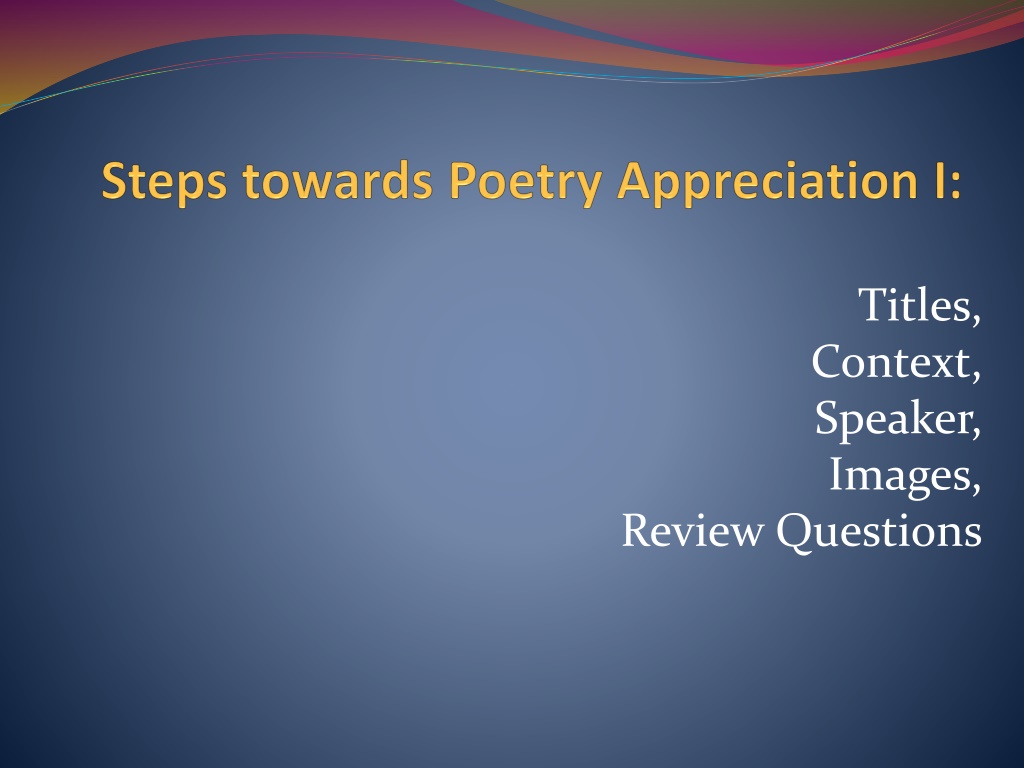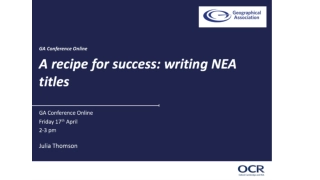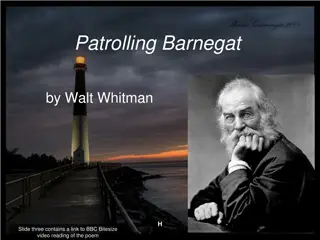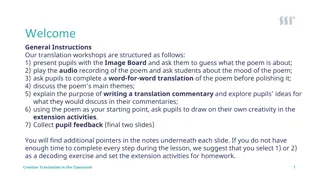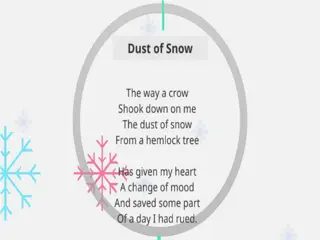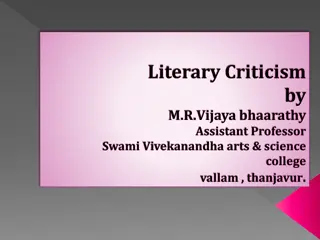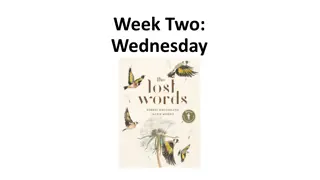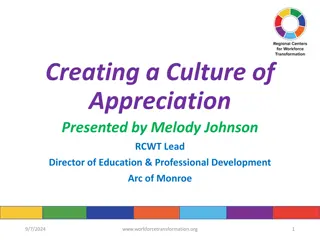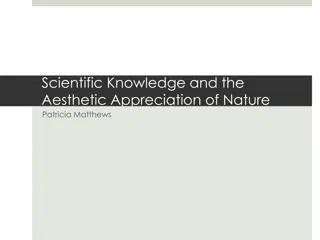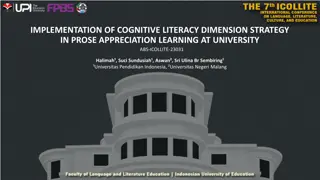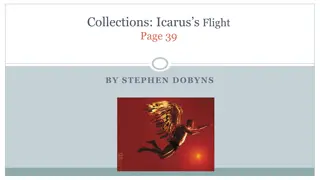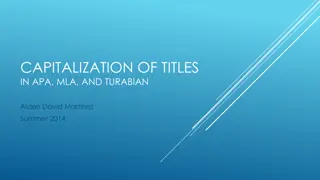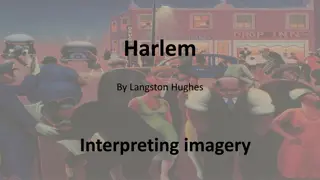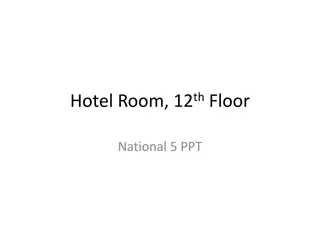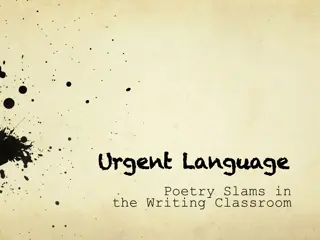Understanding Literary Appreciation and Poem Titles
Literary appreciation involves understanding and enjoying poems, while critical appreciation delves deeper into evaluating their merits and demerits. To understand a poem, one should read it aloud, decipher unfamiliar words, and focus on the overall meaning. Different types of poem titles like Literal, Metaphoric, and Ambiguous titles can offer insights into a poem's theme and content.
Download Presentation

Please find below an Image/Link to download the presentation.
The content on the website is provided AS IS for your information and personal use only. It may not be sold, licensed, or shared on other websites without obtaining consent from the author. Download presentation by click this link. If you encounter any issues during the download, it is possible that the publisher has removed the file from their server.
E N D
Presentation Transcript
Titles, Context, Speaker, Images, Review Questions
Literary Appreciation The word 'appreciation' implies the ability of a reader of any poem to understand and enjoy that poem. It presupposes the ability of the reader to detect the theme and message embodied in the poem; to see the beauty of the lines, sound, language, imagery and message of the poem. It behoves the capacity of any reader to read and enjoy the poem. Critical Appreciation In critical appreciation, a piece of poem is not only appreciated (understood), but subjected to criticism with the aim of finding out how well written the poem appears to be and how the message has been communicated etc. The word 'criticism' means evaluation (or setting a value), analysis or judgement of work of art. In the criticism of a poem therefore, the critic tries to discover the merits and demerits of the poem by investigating all the technical devices used in the poem. Our business as critics of literature is to engage in critical appreciation.
Basic steps towards understanding a poem Read the poem out aloud for the first time. > If there are strange words within the poem, after the first reading, pause and use your dictionary to find out their meanings. > Now read out the poem again with focus on reading out the lines in a way that they begin to make meaning. Thus even if a 'sentence' ends in the middle of the next line, you do not stop until you also get to the middle of that next line. > Read the poem aloud at least three times before you ponder over the meaning of what you have read. > Listen to some of the rhyming of words that will occur to you. Just listen without putting much attention to these rhymes > Now ask yourself the overall impression you have about the poem and what story it tries to tell you.
Types of Title The title of the poem will frequently summarise its theme. Going through several poems, we have noted three major categories of titles: Literal, Metaphoric, and Ambiguous titles. Literal Titles This refers to a title of a poem that directly explains or is connected with the subject-matter or theme, location, person, event or idea in the poem. For example, in the poem 'Africa' by David Diop Metaphoric Titles: This refers to a situation where the title of a poem does not have a direct link to the topic/subject matter being discussed. The title serves as a metaphor for something else that the poem discusses. Example: THE VULTURES by David Diop compare with the nursery rhyme The Vulture Ambiguous Title In an ambiguous title, we see a situation where the title could be perceived as being both literal and figurative. E.g Ifeoma by K.A Ude
Questions on Title To understand the relevance of a poem's title to its meaning and message you ask yourself the following questions: What is the significance of the poem's title? How does its title relate to the theme? Does the title specify a locale for the poem? Is it a name of a person? Does it describe an action? E.g. 'After the Bomb' by Mary Wilson Does the title specify a person to whom the poem is addressed' e.g. 'Christopher Okigbo' by Odia Ofeimun Does the title specify a dominant purpose for the poem? Example 'In memory of W. B. Yeats' by W.H. Auden Does the title allude to some incident or event in literature or history? Example 'July 66' by Pol Ndu and 'May 29,1999' by Chin Ce.
Context of a Poem Context of the poem Poetry is all about life. It captures our view of life or reaction to issues or events in life, it tells a story. Therefore every poem has a context. Sometimes the context or setting of this story could be well described in the poem or life itself would be taken as the context for the story. If the poem is enacting incidents as we see in Coleridge's 'The Rime of an ancient Mariner" we become spectators who merely observe and react (when allowed) to the scene unraveling before us. On the other hand, when a poem takes the whole of life as its context as in Simon Pederek's 'Vultures,' we become participatory audience to the issue being discussed.
Questions on Context To determine the context of the poem and its relevance to the poem you ask the following questions: What is happening in the poem? Where is this action taking place? Is it stated, or is it implied in the poem? Could the context be deduced from the title of the poem? What is the occasion of the poem? What, in other words, prompts the poem? Is the poem prompted by the speaker's encounter with someone, some animal or object? Is there a relationship between the poem's first line and its title? Note: Once context is given in the title, the first line of the poem will take it as assured and simply begin.
Speaker Convention assumes that every poem has a speaker. However, while some speakers will simply function as an organising point of view or 'voice' in the poem, other speakers are clearly differentiated. The highly differentiated speaker is called a persona, and may have all the multifaceted nature of a character in a play. Many a time when a poem does not have an easily recognisable personae, one encounters a central focal point, a 'voice' from which the poet gives his message. Sometimes where such a 'voice' is identifiable with the poet, we call it the 'poet personae.' Let us consider this poem:
Unspoken Agonies by Peter Onwudinjo UNSPOKEN AGONIES by Peter Onwudinjo The forest is deep In mourning. Tears for trees beheaded Defrocked and burnt to stumps; Tears for guts and brains battered to bits . Tears for unspoken agonies Floating in the soot- dust of war. Are those bayonet sounds retreating Or coming? (From Women of Biafra and other Poems)
Questions on Speaker To find out the speaker in the poem we ask the following questions: Who is the speaker? Is the speaker a man or a woman? (What makes you arrive at this conclusion?) Does the speaker have a name? Does the speaker have a well-defined identity or does he function as an I point of view for the sake of the poem? How does the speaker feel about the incident, idea, event, object, or person described in the poem? Does the speaker express any of his feelings in poem? Is the speaker differentiated as a person in the poem? Does he express any well-defined feelings or attitudes? Does the speaker express any peculiarities or idiosyncrasies? What is the speaker's motive for feeling or thinking the way he does? Does the speaker's motive for feelings or attitude coincide with the way a 'reasonable man' might be expected to feel? Are his feelings and attitudes peculiar to him? (if so, the I is not merely an organising viewpoint, but a persona or character).
Language and Imagery The language of poetry and indeed of all works of art is referential. This means that the context gives different connotative meanings to the language. For example, when 'home' is used in a poem, the meaning does not end with just the physical structure of a building. The connotative derivative meaning could include the image of a loving husband or wife, house bills, a nagging wife, children, a drunk of a father, a wayward daughter or delinquent son. Poetry uses imagery in a variety of ways as we have noted. It could be used to reinforce a speaker's perceptions of the world or to emphasize subtle meaning.
Questions on Imagery To discover the imagery used in a poem we ask the following questions: What imagery does the speaker use in his descriptions? Do the images have anything in common? Do they cluster around a dominant theme or impression? Is there common thread of meaning between these images? How do these images colour the speaker's perceptions of the world? Do these images suggest or imply any attitude peculiar to the speaker? Is the imagery used to describe any object consistent with the way the object is typically regarded? Does the imagery suggest any special meaning for the object? (If so, the object may be functioning as a symbol in the poem)
Review Questions Practice with any two poems of your choice.
Poetry is fun Thank You
